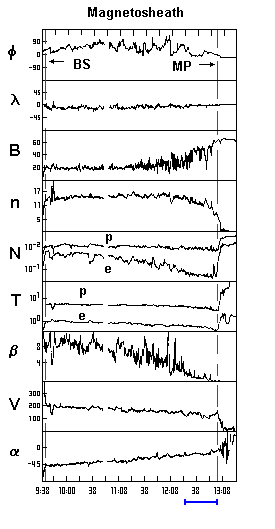 Magnetosheath
Magnetosheath
spaceweb@oulu.fi - last update: 30 December 1998, 1450 UT

Introduction
The region between the bow shock
and the magnetopause is called the
magnetosheath. The particles in this region originate from the shocked
solar wind, as can be defined from
their charge state and composition (Gloeckler et al., 1986).
The plasma density typically decreases
from the bow shock to the magnetopause; however, it is always higher
than the magnetospheric plasma density.
The magnetic field is weaker than the magnetospheric field, and it
is deflected from the
near-IMF orientation in the outer
magnetosheath toward a draped orientation near the magnetopause.
Some of these basic features can be seen in the figure that shows
an overview of inbound pass of magnetosheath at the equatorial
plane (Phan et al., 1994). Note that energetic particles (N) are
much more abundant in the magnetosphere than in the magnetosheath.
Plasma and magnetic field
Typical magnetosheath particle energies are 1 keV/e for ions and
about 100 eV for electrons. Densities are typically around
20 cm-3. Fluctuations in the plasma (and also magnetic)
parameters are very typical, and may be due to passages of
solar wind features like shocks and
tangential discontinuities or different types of waves.
Variations can also be due to the radial gradient of the
parameters combined with radial motion of the bow shock -
magnetosheath - magnetopause system, which can be driven
by changes in the IMF orientation (Sibeck and Gosling, 1996).
The angle between the magnetosheath and magnetospheric magnetic
fields defines the magnetic shear across the magnetopause.
When the magnetic shear is low
(< 30 degrees), a magnetosheath transition layer, also
called the "plasma depletion layer" is formed
just outside the magnetopause (marked with the blue line in
the figure).
The magnetic field direction inside the magnetosheath is important
also for the proposed merging process
with the geomagnetic field. It is the north-south direction
of the field that matters in that case.
Precipitation and other phenomena
The magnetosheath plasma forms an important part
of the low energy dayside auroral precipitation
. This is because the plasma has an entry to the ionosphere
via the dayside cusps and the magnetospheric
boundary layer .
A characteristic feature of magnetosheath is the existence of narrowband,
whistler mode
electromagnetic waves termed "lion roars". They occur in intense and sporadic
bursts around 100 Hz, corresponding to 0.25 - 0.5 times the electron
cyclotron frequency, with average duration of 1-2 s (Smith et al., 1969;
Smith and Tsurutani, 1976; Zhang et al., 1998).
Just as many magnetospheric regions, also magnetosheath contains
broadband electrostatic noise (BEN; Anderson et al., 1982).
References
- Anderson, R. R., C. C. Harvey, M. M. Hoppe, B. T. Tsurutani, T. E. Eastman,
and J. Etcheto, Plasma waves near the magnetopause,
J. Geophys. Res., 87, 2087-2107, 1982.
- Gloeckler, G., et al., Solar wind carbon, nitrogen and oxygen abundances
measured in the Earth's magnetosheath with AMPTE/CCE, Geophys. Res. Lett., 13,
793, 1986.
- Phan, T.-D., G. Paschmann, W. Baumjohann, N. Sckopke, and H. Luhr,
The magnetosheath region adjacent to the dayside magnetopause: AMPTE/IRM
observations, J. Geophys. Res., 99, 121-141, 1994.
- Sibeck, D. G., and J. T. Gosling, Magnetosheath density fluctuations
and magnetopause motion, J. Geophys. Res., 101, 31-40, 1996.
- Smith, E. J., R. E. Holtzer, and C. T. Russell, Magnetic emissions
in the magnetosheath at frequencies near 100 Hz,
J. Geophys. Res., 74, 3027-, 1969.
- Smith, E. J., and B. T. Tsurutani, Magnetosheath lion roars,
J. Geophys. Res., 81, 2261-, 1976.
- Zhang, Y., H. Matsumoto, and H. Kojima, Lion roars in the magnetosheath:
The Geotail observations, J. Geophys. Res., 103, 4615-4626, 1998.
See also:
 Magnetosheath
Magnetosheath Magnetosheath
Magnetosheath